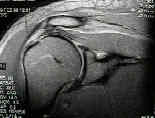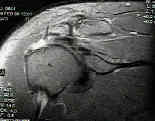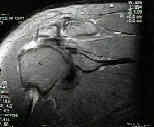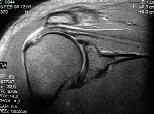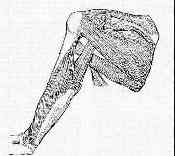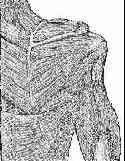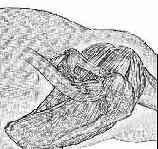
- See: partial rotator cuff tear
- Discussion:
- rotator cuff anatomy
- frequency of tear
- diff dx of cuff tears: (partial rotator cuff tear)
- etilogy of tear:
- impingement syndrome: (75%)
- shoulder instability (anterior or multi-directional) (15%) (should be considered in any young active patient);
- trauma:
- occurs in 10% of patients;
- note that a displaced greater tuberosity frx is a RTC tear equivolent;
- functional considerations:
- references:
- Subacromial Injection Improves Deltoid Firing in Subjects with Large Rotator Cuff Tears.
- Differences in muscle activities during shoulder elevation in patients with symptomatic and asymptomatic rotator cuff tears: analysis by positron emission tomography.
- Tears of the rotator cuff of the shoulder associated with pathological changes in the acromion: A study in cadavera.
- Symptomatic rotator cuff tears show higher radioisotope uptake on bone scintigraphy compared with asymptomatic tears.
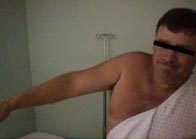
- Shoulder Exam:
- impingement sign and test
- it is essential to document ROM deficits, since rotator cuff repair would not be expected
to yield a good outcome in the face of fixed shoulder contractures;
- Radiographic Findings:
- scapular outlet view
- 30 deg caudal tilt view AP view
- arthrography
- MRI of Shoulder: Coronal Oblique View of Shoulder
- Non Operative Management:
- in the study by Goldberg BA, et al. (2001), the authors documented the functional outcome in a consecutive series of 46 patients;
- following inclusion criteria:
- full-thickness rotator cuff tear seen by ultrasonography, arthrogram, or magnetic resonance imaging;
- absence of a Workers’ Compensation claim or previous surgery;
- followup of at least 1 year;
- election of nonoperative management by the patient;
- 26 of the tears involved only the supraspinatus, two involved the supraspinatus and infraspinatus, and two involved supraspinatus,
infraspinatus, and subscapularis (16 reports did not specify the size of the tear).
- treatment consisted only of patient education and a home program of gentle stretching and strengthening;
- at average followup of 2.5 ± 1.6 years, 27 (59%) patients experienced improvement with nonoperative treatment, 14 (30%) patients experienced
worsening, and five (11%) patients remained unchanged;
- references:
- Nonoperative treatment of rotator cuff tears.
- Conservative treatment of rotator cuff tears.
- Results of nonoperative management of full-thickness tears of the rotator cuff.
- Nonoperative management of full-thickness tears of the rotator cuff.
- Outcome of Nonoperative Management of Full-Thickness Rotator Cuff Tears.
- Evolution of Nonoperatively Treated Symptomatic Isolated Full-Thickness Supraspinatus Tears



